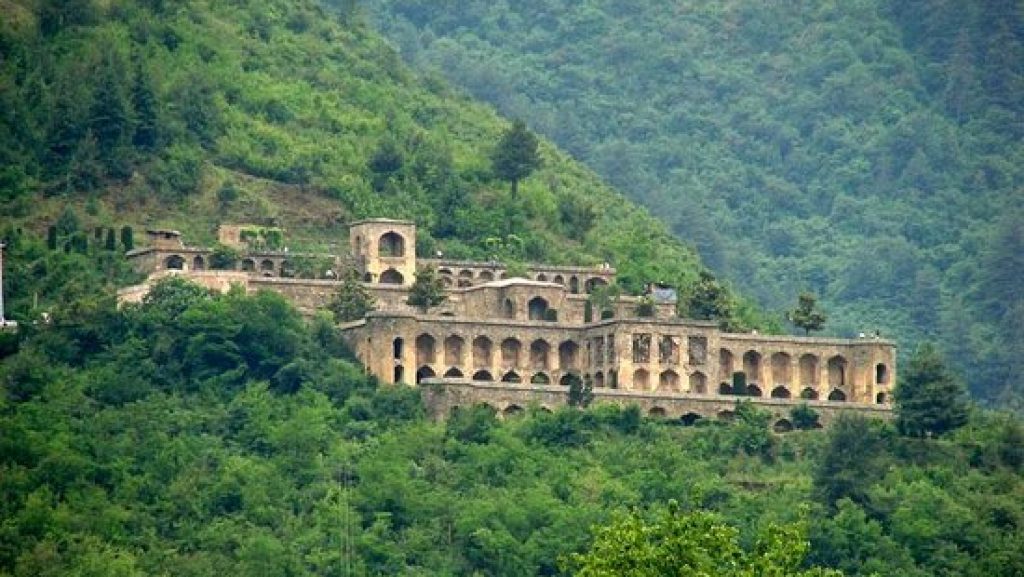There are many historic monuments and sight-seeing spots in Srinagar that attracts the travelers all around the world. The Pari Mahal is one of them that calls for special mention. It showcases appealing beauties in its bricks, walls and holds rich story of the past.
Photo Courtesy : srinagar.nic.in
Located atop Zabarwan mountain and about 5 Kms from Srinagar, Pari Mahal is a great tourist attraction. It is situated towards southwest of Dal Lake near the famous Cheshma Shahi Garden. It consists of six terraces with arched retaining walls supporting the terraces against the mountain. There are no water cascades in this garden, unlike other Mughal gardens. The garden is about 122 meters in length and about 63 meters in width at its widest point.
Pari Mahal was built in the mid-seventeenth century on the ruins of a Buddhist monastery by prince Dara Shikoh, the eldest son of Shah Jahan. Dara Shikoh, a follower of the Qadiri order of Sufi Islam, had a great interest in mysticism and he built the garden for his Sufi tutor, Mullah Shah Badakhshi. It was used as an observatory for the teaching of astrology and astronomy. Prince Dara was assassinated in 1659 by his younger brother Aurangazeb, who went on to take control of the empire.
The terraces of Pari Mahal are accessed via sets of steps on their corners. Each flight of steps measures 6.7 m by 1.3 m. At the center of the sixth or uppermost terrace, a water tank with an arched wall is set against the mountain slope. This water tank, which measures 3.43 meters long by 1.52 meters wide on the inside, received water from a
water spring located above it that has since gone dry. Previously, the water entered the tank via an arched drain in front of the wall. From the sixth terrace, a baradari, or pavilion, overlooks the lower terraces. This baradari is built on two levels, projecting out over the retaining wall between the fifth and sixth terraces; the upper level is entered from the sixth terrace, while the lower is entered on the fifth terrace.
The fifth terrace has a water tank built of white marble and measuring 12 meters by 8.07 meters; this tank is centered on the axis of the baradari on the sixth terrace. Since no water canals are evident on the site, it appears that the tank received its water through an underground system of pipes. The retaining wall on the fifth terrace has twenty-one arches of rough masonry construction, which decrease in size moving from the center of the terrace outwards. Above the arches is a series of smaller arches, set back closer to the retaining wall. These upper arches increase in size towards the outer corners of the terrace, visually balancing the decreasing size of the arches below. Only the central arch of this wall, which also forms the lower part of the baradari from the sixth terrace, is plastered.
The entrance complex is found on the fourth terrace, which also features an arched rough masonry retaining wall in somewhat better repair than that between the two upper terraces. This wall is further ornamented with niches within each arch. Unlike the retaining wall between the fifth and sixth terraces, the arches of this wall are all uniform in height. Above them, a series of shallow rectangular niches, recessed behind the level of the arches, decorates the upper part of the retaining wall. A plastered baradari with openings on all sides sits on the edge of the terrace; its northern side projects beyond the terrace retaining wall between the fourth and third terraces.
The lower three terraces are simpler in design than those above, which has led to conjectures that the uppermost terraces were reserved for the prince. The third terrace has a water tank which possibly was housed within a since-collapsed baradari. This water tank also projects beyond the terrace wall, and is supported by arcades on the second terrace below. The walls of this projection contain niches on two levels: blind arcades on the lower level and rectangles on the upper level. These rectangles are subdivided into small squares, probably intended to host pigeons. The upper arcade here forms a colonnade that runs in front of its retaining wall. The first terrace holds only a rectangular water tank, on axis with its centerline; it has no retaining wall below it.
After being left in a state of ruin for many years, the garden recently underwent minor renovations, such as the plastering and painting of arcades on the retaining walls. In addition, the side windows on baradari were closed. The garden is illuminated at night.
Sources:
- Gardens of Paradise : The History and Design of the Great Islamic Gardens by John Brookes.
- Ancient Monuments of Kashmir by Ram Chandra Kak.
- Encyclopaedia of Kashmir by Suresh K. Sharma, and S. R. Bakshi.

